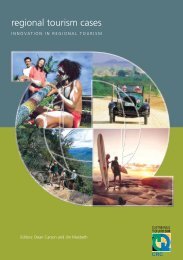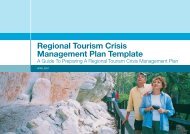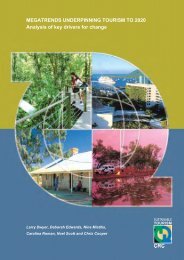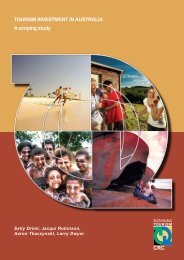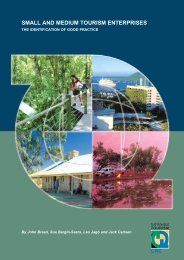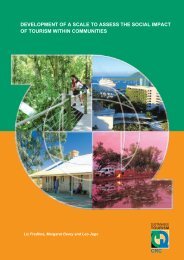Tourism Risk Management - Sustainable Tourism Online
Tourism Risk Management - Sustainable Tourism Online
Tourism Risk Management - Sustainable Tourism Online
You also want an ePaper? Increase the reach of your titles
YUMPU automatically turns print PDFs into web optimized ePapers that Google loves.
elated health and safety and reinforce the need for government and community agencies to support<br />
tourism operations and initiatives.<br />
Whilst legislation relating to occupational health and safety varies from country to country, common<br />
elements generally include:<br />
• liability (being legally responsible for actions and activities) is a two-way street with both the<br />
employer and employees being liable for their actions;<br />
• duties of employers and employees and penalties for non-compliance;<br />
• the provision of a work environment that is safe and without risk to health;<br />
• the provision of adequate facilities;<br />
• maintenance of a safe means of access and egress;<br />
• ensuring the absence of risks in connection with handling of plant and substances;<br />
• development of procedures for emergencies within the facility or workplace;<br />
• adequate training of staff and testing of plans and procedures; and<br />
• provision of information in appropriate languages.<br />
Destinations should advise tourism businesses/organizations to develop, as a minimum, Standard<br />
Operating Procedures (SOPs) for their facilities to address:<br />
• evacuation;<br />
• building fire;<br />
• bomb, chemical, biological, radiological threat;<br />
• suspected mail bomb/letter bomb;<br />
• civil disorder/illegal occupancy;<br />
• armed or dangerous intruder;<br />
• hazardous material spill;<br />
• gas leak or other noxious exposure;<br />
• building collapse;<br />
• medical emergency; and<br />
• external emergencies – storm, flood, earthquake, tsunami, landslide, etc.<br />
Again, regional and local emergency services personnel can provide expert advice on the<br />
development of these procedures and this provides an important opportunity for an effective<br />
partnership between tourism and community agencies.<br />
2. Preparedness<br />
This strategy includes the development of plans and programs, systems and procedures, training and<br />
testing to ensure that when crises do occur, resources (personnel and equipment) can be mobilized<br />
and deployed to best effect to reduce the effects of the crisis and to facilitate the return to normal<br />
tourism operations.<br />
<strong>Tourism</strong> <strong>Risk</strong> <strong>Management</strong> – An Authoritative Guide to Managing Crises in <strong>Tourism</strong> 53



